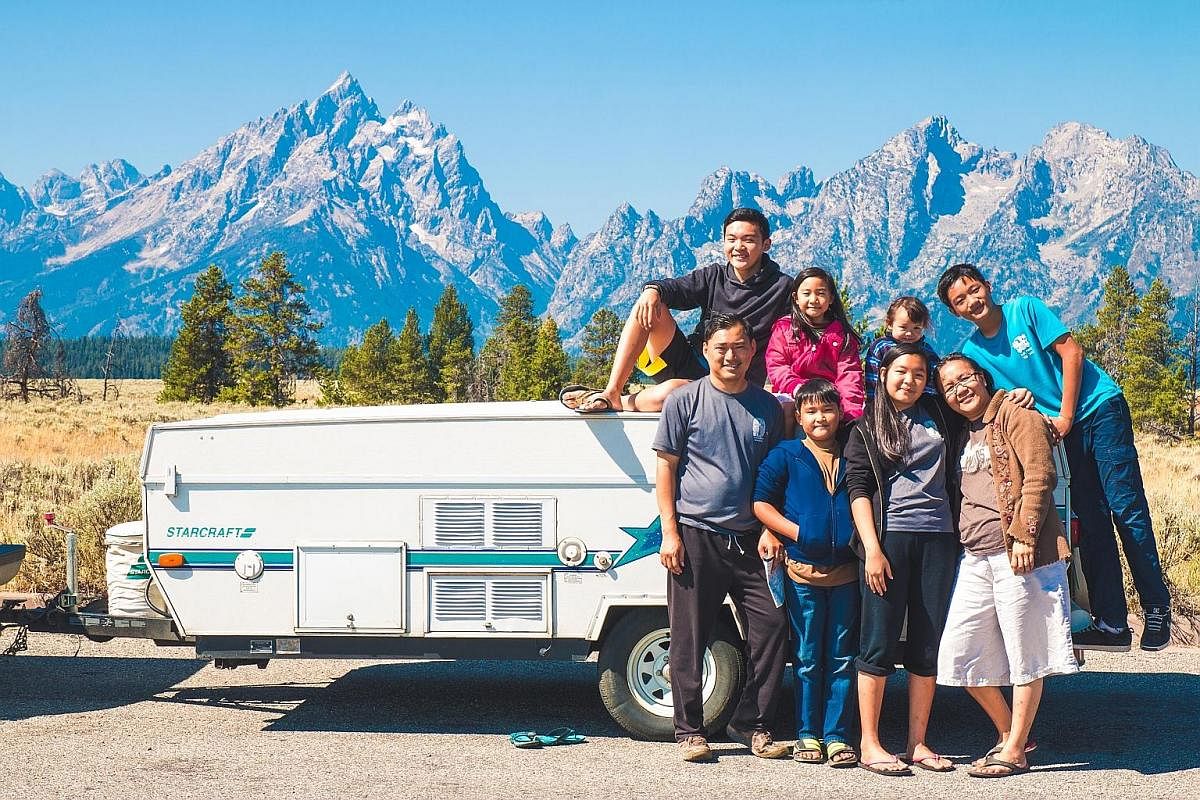-
By the numbers
-
Fast facts about the Ong family's trip to the United States:
8 people went to
1 country, where they visited
43 states
20 cities
24 campsites
20 national parks
20 museums
7 capitol buildings and
2 military bases, as well as saw
2 space shuttles and bought
108 fridge magnets
21,139 kilometres was the total distance they travelled.
Singaporean family of eight go on a six-month road trip in the United States
The Ong family went on a six-month trip to the United States in 2015 and their travel stories are published in a new book

Educator Dan Ong, his wife Sue and their six children took a six-month road trip across the United States in 2015. One of the parents' fondest memories of the adventure does not involve the Statue of Liberty nor the Grand Canyon - it is the family sharing a loaf of bread when they ran out of money.
"I saw the children's understanding of the situation. They were taking care of one another. We were rationing what we had," says Mr Ong, 45, a programme manager and educator at a learning centre.
The incident is one of many adventures that Mrs Ong, 41, a stay-at-home mum, has written about in a book on their trip, 6 Kids And A Pop-up Camper.
Launched last month, the book features photographs taken by eldest son Asher, 16, and contributions from the rest of the family. It retails for $61.95 at 6kidsandapopupcamper.com.
They travelled to 43 out of 50 American states in six months, clocking more than 21,000km. Mr Ong estimates they spent about $50,000 in total, and did not stay in hotels or motels.
Mrs Ong's childhood dream, influenced by growing up watching Sesame Street and American sitcoms, was to travel to the US. What might seem like a radical American holiday to some was merely the Ongs' way of seeing as much of the country as they could on a shoestring budget.
"We wanted to have a shared experience as a family, something special that only eight of us would have, before the kids grow up and move on," says Mrs Ong.
The Ongs decided to do the road trip in 2015, using their savings and some money given by family members, because their firstborn Asher, then 15, would eventually have to do his national service and tertiary education, and would be unable to travel for six months.
Before their youngest child, Michaela, was born, they took their five children on a 24-hour coach trip from Singapore to Ranong in southern Thailand.
Although the children - aged four to 16 - are homeschooled, the family's preparations for the trip included getting permission from the Ministry of Education for their son, Isaac, who was due to take the Primary School Leaving Examination (PSLE) in 2015, to defer taking the examination till the following year. Homeschooled children are not exempt from this national examination.
Mr Ong also had to leave his job of 17 years as a secondary school teacher to go on the trip.
Mrs Ong also got the older children, the youngest of whom was three at the time, to look at online resources such as information on antebellum houses in Charleston, South Carolina, and watch snippets of Gone With The Wind (1939).
With a view to writing a book, hopefully to recoup costs, the family started a public Facebook page to document the journey. It now has about 9,200 followers.
Besides keeping up with their church and family friends in the US and Singapore, they met strangers who contacted them through Facebook.
Initially uncomfortable that the children were not studying much, though they had taken along textbooks on the trip, Mrs Ong soon experienced a "paradigm shift".
She says: "The kids were learning so much. They were looking at mountains and valleys and encountered hail. We saw flash floods unfold in Zion National Park in Utah."
They also learnt what they had to do as a family to pull through tough times. In South Dakota, Mr Ong tried to withdraw cash from an ATM, only to realise he had reached his credit limit.
Dangerously low on petrol and food, they waited for the funds to be transferred. The children sat at a foodcourt and waited as their parents tried in vain to access the money at their bank branch.
The family eventually scrounged for loose change in their pockets and in the used station wagon they had bought in the US for the trip. They had spent $8,000 on the car and the camper trailer, in which they slept at night when they were not staying with friends.
They rustled up enough to buy a loaf of bread, which they ate with leftovers: ham, soggy lettuce and Cheerios, a breakfast cereal. Later that day, Mr Ong tried his luck again at a petrol kiosk and, unexpectedly, the card cleared his request to buy petrol.
They drove to their next destination, Casper, Wyoming, where they stopped for the night at a campsite and Mrs Ong cooked instant noodles.
She says: "We never imagined how a trip could change our lives. When you do a trip like this, you put yourself out there, you make yourself vulnerable. We met new people, which opened up new opportunities. If you planned everything to the letter, you might miss out on something."
Besides Americans who welcomed them into their homes, many Singaporeans in the US contacted the family to arrange to meet. A Singaporean they met at a barbecue, organised by another Singaporean, was working at Pixar and gave the family free tickets to Disneyland, worth about $1,000.
Mrs Ong had told the children they were not going to Disneyland as they could not afford it.
Having a tight budget meant "we lived like vagabonds for six months", says Mrs Ong.
The family mostly visited free attractions such as museums and monuments. They did not have much cash for souvenirs, although Mrs Ong bought 108 fridge magnets to commemorate their trip.
They spent prudently, for instance, investing in a family pass to the national parks for US$80 (S$115). Besides visiting attractions such as the Statue of Liberty, they saw 20 of about 60 national parks in the country, including Yellowstone National Park.
They often slept in their camper, which the boys and Mr Ong set up when it was time for bed.
The camper covering, made of canvas, meant they had to put up with temperatures of between 10 and 40 deg C.
On several occasions, there was no campsite available, so they spent the night at a Walmart carpark, sleeping in the car as they were not allowed to open up campers, says Mrs Ong, who learnt to wash her hair in public toilets.
"You learn to adapt. We're resilient," says Asher.
Around the US on a tight budget
Mrs Sue Ong's tips on taking a long trip in the United States with a big family on a small budget:
• Buy an old but well-maintained car. They are affordable by Singapore standards. At the end of the trip, you can sell it and recoup some of the costs.
• Skip hotels and make your own sleeping arrangements, for example, sleeping in a camper or tents. Camp grounds are affordable and easy to find.
• Skip restaurants. Shop for groceries and cook simple meals. "If you have no opportunity to cook, we found affordable options such as fresh and nutritious submarine sandwiches sold in the larger grocery stores. The large pizzas sold at 7-Eleven stores in the US were also a favourite with our kids," Mrs Ong says.
• Skip tourist attractions that charge fees. "The US is not short on wonderful things to see and do for free. For example, most of the world-class museums in Washington, DC are free of charge to visit," she says.
• Shop at thrift stores. It is not difficult to find them in any American city or town. These stores are typically large and sell just about anything you need, such as clothes (including winter clothing), shoes and kitchen necessities.
Join ST's Telegram channel and get the latest breaking news delivered to you.
A version of this article appeared in the print edition of The Sunday Times on January 08, 2017, with the headline Singaporean family of eight go on a six-month road trip in the United States. Subscribe

